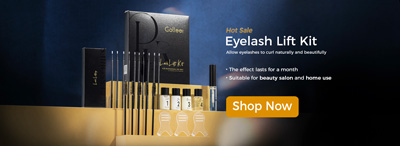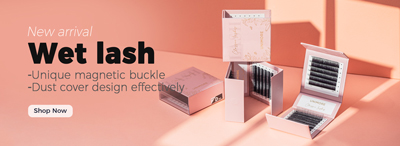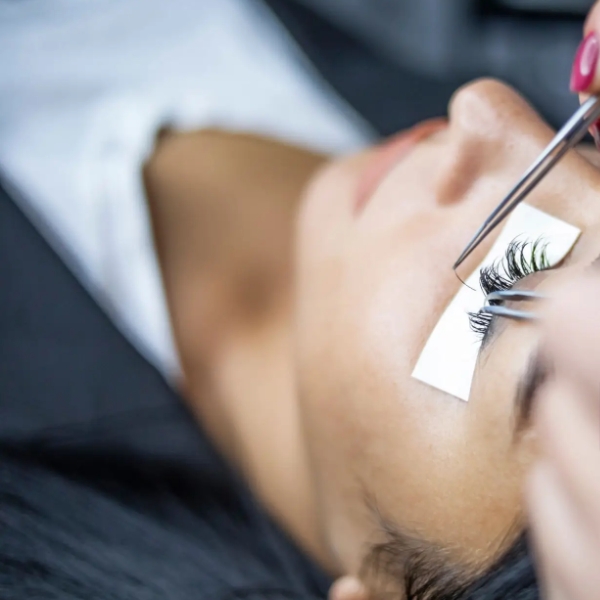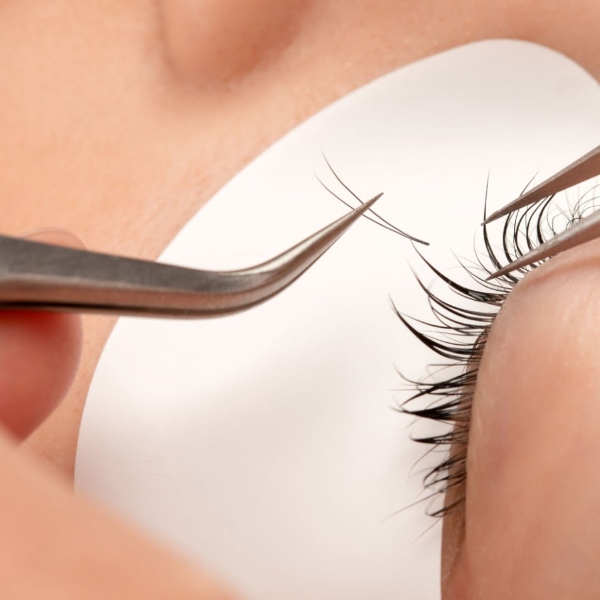The training courses for semi-permanent eyelash extensions vary, meaning that technicians can be trained to use either lash accelerator and primer, just one of them, or neither of them at all! Consequently, many lash artists come to different conclusions regarding whether or not they like to use them.
Primers and lash accelerators are products that can significantly improve the results of treatments, so it is important to understand how each one operates.
We have included everything you need to know about eyelash extensions, so whether you are just starting in the world of eyelash extensions or aren’t sure whether you should be using a lash accelerator or a primer, you can find everything you need to know right here. Some eyelash technicians may have been instructed on how to use an eyelash accelerator, others may have been instructed on how to use a primer, and others may have been instructed on how to use both of these products. Although lash accelerators and primers serve distinct functions, they are designed to help clients get the most out of their lash extensions by extending their wear time. After reading this, you might stick with just one of the two methods; there is no correct or incorrect approach; what matters is what you discover works best for you. We strongly advise you to experiment with new methods and products because you never know if doing so will bring you one step closer to creating the ideal set of eyelash extensions.
So that you can form your own opinion regarding the primer and the accelerator, how to use them, how they function, and the benefits they offer, as well as the similarities and differences between them, let’s talk about how to use them.
- 1 To begin, let’s talk about what a lash accelerator is.
- 2 What exactly constitutes a lash primer?
- 3 What are the components of a lash extension primer?
- 4 What exactly is the difference between the two?
- 5 The Advantages of Utilizing Lash Primers
- 6 The Advantages of Utilizing Lash Accelerators
- 7 Preparation of the Eyelashes for the Application of Lash Extensions
- 8 What will happen if the natural lashes are unprepared for the extensions before they are applied?
- 9 What should you recommend that clients do to get themselves ready for their appointment?
- 10 Final thoughts
To begin, let’s talk about what a lash accelerator is.
Your client’s natural eyelashes should not be treated with a lash accelerator; they should only be used on the eyelash extensions that they have applied. You should continue applying this product throughout the lashing process, approximately every 40 minutes. This product helps reduce the time it takes for the eyelash adhesive to cure, reducing the time it takes to apply the eyelashes. Because the glue sets more quickly when using this product, many professionals report that their customers’ eyelashes stay in place for significantly longer. This is because many customers disregard the advice given for 24 hours after application, and as a result, they get them wet before they have fully cured, for example. As a result of the lash accelerator reducing the time needed for the curing process, there is less opportunity for your client to make the mistakes that lead to the premature loss of their extensions.
What exactly constitutes a lash primer?
Only your client’s natural eyelashes should be primed with lash primer; the extensions should not be primed at all. As a form of pre-treatment, eyelash primer is applied before applying for eyelash extensions. This is done because primer helps strengthen the bond between the real eyelashes and the extensions. But how exactly does it accomplish this? The primer’s contribution to achieving the ideal PH level significantly strengthens the bond between the two sets of lashes. Because the primer makes the surface of the client’s lashes rougher, it allows the lash adhesive to create a better bond due to the improved grip it provides, reducing premature lash loss.
What are the components of a lash extension primer?
In our opinion, the following are the primary components that every lash primer ought to have:
To begin, acetone, more commonly known as dimethyl ketone, is capable of some pretty incredible things. It has astringent properties, so it can remove oil and dirt from the skin’s surface.
The second substance is poly ethanol, more commonly referred to as alcohol. Even though there is only a small amount in each primer, it can wash away the dirt and oil, helping you prepare the perfect foundation to begin your work. It may also help calm reactions in particularly sensitive clients.
And last but certainly not least the age-old H20, also known as water.
What exactly is the difference between the two?
Primers are applied to the client’s natural eyelashes, while lash accelerators are utilized when applying for the eyelash extensions.
Primers help with retention by creating a stronger bond between the client’s natural eyelashes and the eyelash extensions. Primers are applied before eyelash extensions are applied. The curing time of the eyelash adhesive that is used can be sped up with the use of lash accelerators.
When used together, they have the potential to significantly lengthen the wear time and reduce the risk of a premature breakout.
The Advantages of Utilizing Lash Primers
Those with oily or greasy skin, hair, or lashes may find this product helps them retain more natural oils. These customers typically observe that their extensions do not last as long as those of other clients and experience a significant amount of premature hair loss. Remember that eyelash extensions and oil do not get along very well together. Because the lash primer causes the lashes to have a rougher texture, the bond between the client’s natural eyelashes and the extensions is much stronger! This allows the lash primer to effectively control the amount of oil in the lashes.
The Advantages of Utilizing Lash Accelerators
Eyelash adhesive requires some time to cure, but lash accelerators cut that time in half. Because of this, the eyelash extensions you apply to your client will most likely last longer than they would have if you had not used an accelerator.
Some eyelash adhesives dry more slowly than others; however, if this is the case, your go-to glue can still be your favorite by combining it with a lash accelerator.
Preparation of the Eyelashes for the Application of Lash Extensions
Before beginning to apply lashes, you should thoroughly consult with your client and briefly examine their existing lashes. Find out the thickness and length of your client’s lashes, as well as their expectations for them. It is helpful to have photographs of your previous work in various styles to give your client an idea of the look you can achieve.
As a first step in preparing the area, you should ensure that the bottom lashes, including the shorter blonde ones, are all secured with tape. There are a few different approaches to this, but my favorite is taping the lashes down with micropore tape first and then applying the Premium Eye Pads afterward.
Cleansing! Your client will arrive at their appointment with lovely clean lashes free of makeup if they are a dream client. This is not always the case, so when it is, I use the Purified Eyelash and Eyelid Cleanser with the cleansing brush to thoroughly clean the area and then wash it through.
A VERY IMPORTANT HINT: Before moving on to the next step, check to see that the lashes are dry. When the lashes are damp, the adhesive will not stick to them properly.
Priming is something that can be accomplished in a few different ways. If your client’s lashes are naturally oily, the Primer, Cleaner, and Accelerator kit is the way to go. A very small amount, wiped over the lashes, is all needed to remove any oil, dust, or makeup particles left behind on the natural lashes. Additionally, it shortens the time required for the adhesive to set.
TIP OF THE DAY you can also use a Microbrush on the bottom of your lash strip so that when you put the lash extension into the glue, it dries quicker (make sure it’s completely dry, which can take a couple of minutes). Alternatively, you can just use it on the lashes; however, trying both methods and working with whichever one you prefer is always a good idea.
You could also use a is a PH balancer. This product helps ensure that the natural lashes are not overly acidic or alkaline, which can cause poor retention of eyelash extensions. Using an application method analogous to the primer, place a small amount of product on a micro brush and drag it along the lash line, working from the root to the tip. Using only a small amount is necessary, and you must let the natural lashes dry before proceeding.
What will happen if the natural lashes are unprepared for the extensions before they are applied?
This is such a source of frustration; brush-offs! After carefully selecting, isolating, and applying individual lashes, the applied lashes fall off when you brush through them.
Poor retention means the lashes fall out earlier than they should, and your client needs infills a lot sooner than planned. This can cause your client to become dissatisfied that they have spent money and time on lashes that do not last as long. At this point, they may look for another technician or decide to forego getting eyelash extensions altogether.
Lashes need to be cleaned because not only will you be working in that area for a significant amount of time, but you also won’t get an amazing finish if there is still dirt lurking around. It’s unsanitary, and since the eyes are already vulnerable, you need to take extra precautions to protect them from infection.
What should you recommend that clients do to get themselves ready for their appointment?
Encourage them to use mascara that isn’t waterproof instead in the days leading up to their appointment. This is because the compounds in the product adhere to the lashes even after they have been cleaned, which is why this happens. These compounds can potentially inhibit a bond from forming between the adhesive and the lashes.
Request that they wash their face in preparation for their appointment. More time can be spent lashing because there will be less time spent cleaning the area. When you have appointments right after the other, removing all of your makeup is difficult because you have so much of it on.
At long last, take a load off and relax! Remember that you are a lash queen, which means your client is in good hands!
Final thoughts
The primary distinction between an eyelash primer and an eyelash accelerator lies in their application and intended effect on the lash treatment. Remember that while primers are used on natural and artificial lashes, accelerators are only used on the latter to aid the glue.
Primers are designed to strengthen the adhesive bond, while accelerators are meant to reduce the adhesive’s setting time and bring it back into equilibrium.






